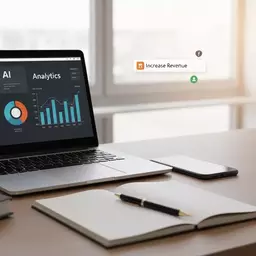Lead Generation: Traditional vs AI

With the rise of AI technologies, lead generation has taken a transformative leap from traditional methods. As businesses navigate this shift, understanding the nuances between these approaches is essential for optimizing success. Here’s what you need to keep in mind as you adapt your strategies.
What You Will Learn
- Traditional lead generation methods like cold calling and manual outreach can be time-consuming and yield low conversion rates.
- AI-powered solutions streamline the lead generation process through automation, predictive analytics, and personalized communications.
- Understanding your target audience and assessing resources are critical steps for defining effective lead generation strategies.
- Implementing AI tools requires careful planning, including evaluating integration capabilities and training your team for success.
Evolution of Lead Generation Strategies
This visual illustrates the shift from traditional to AI-powered lead generation methods, highlighting key characteristics, challenges, and enhancements of each approach.
Traditional Lead Generation
Key Techniques
- • Cold Calling
- • Manual Outreach
- • Networking
Challenges Faced
- • Time-Consuming
- • Limited Reach
- • Low Conversion Rates
AI-Powered Lead Generation
AI Technologies
- • Predictive Analytics
- • Chatbots
- • Lead Scoring
Machine Learning Benefits
- • Automation
- • Data-Driven Insights
- • Personalization
Understanding Lead Generation: A Shift from Traditional to AI-Powered Solutions
Lead generation has transformed dramatically over the years. As we navigate the complexities of the digital age, traditional methods are increasingly being replaced by AI-powered solutions. In this section, I’ll explore the differences between these two approaches and how businesses like yours can benefit from this shift.
Defining Traditional Lead Generation Methods
In the realm of traditional lead generation, techniques such as cold calling and manual outreach have long been staples. These methods rely heavily on personal interaction and time-consuming processes to connect with potential clients. While they can be effective, they often come with significant limitations.
Key Techniques: Cold Calling and Manual Outreach
- Cold Calling: This involves reaching out to prospects without prior interaction. It often requires resilience and a well-prepared script to engage potential customers effectively.
- Manual Outreach: Sending personalized emails or messages to specific leads, manually researching each contact to tailor communication.
- Networking: Attending events and meetings to build relationships and generate leads through personal connections.
Though these techniques have their merits, they demand significant time and effort, often yielding limited results. As a business owner, you might find yourself overwhelmed by the need to continuously hunt for new leads. For more insights on lead generation, you can refer to these lead generation statistics.
Challenges Faced in Traditional Approaches
Traditional methods come with a set of challenges that can hinder your success. Here are a few common issues:
- Time-Consuming: Each outreach effort can take considerable time, leaving you little room for other essential business tasks.
- Limited Reach: The scope of your outreach is often restricted, which can prevent you from tapping into larger markets.
- Low Conversion Rates: Many leads generated through traditional methods may not convert, leading to wasted resources.
These challenges highlight the need for more efficient and effective solutions. As we transition to AI-powered strategies, we can address these issues head-on.

The Rise of AI-Powered Lead Generation
With the advent of technology, we have witnessed a significant rise in AI-powered lead generation solutions. These innovative tools are designed to streamline the lead generation process, making it easier and more effective for businesses of all sizes.
Introduction to AI Technologies in Sales
AI technologies have revolutionized the way we approach sales. By leveraging data analytics, machine learning, and automation, businesses can optimize their lead generation efforts. This transition not only improves efficiency but also enhances the quality of leads generated. To learn more about how AI is transforming lead generation, check out this resource on AI lead generation.
How Predictive Analytics and Chatbots Enhance Lead Quality
- Predictive Analytics: Uses historical data to forecast future trends, helping to identify high-potential leads.
- Chatbots: Provide instant communication with potential clients, capturing information and answering queries, which leads to enhanced engagement.
- Lead Scoring: AI algorithms assess lead quality based on behavior and engagement, ensuring sales teams focus on the most promising prospects. For a comparison of AI lead scoring versus traditional methods, see this detailed article.
By integrating such AI technologies, you can significantly improve the quality and efficiency of your lead generation strategies. It’s a game-changer for small and medium-sized businesses looking to maximize their potential.
The Role of Machine Learning in Improving Lead Generation
Machine learning plays a crucial role in refining lead generation processes. It continuously learns from data patterns and can adapt strategies over time. Here’s how:
- Automation: Many repetitive tasks can be automated, freeing up your team to focus on higher-value work.
- Data-Driven Insights: Machine learning algorithms provide actionable insights, helping you make informed decisions about your lead generation strategies.
- Personalization: Tailors communications to individual leads based on their preferences and behavior, increasing the chances of conversion.
As you consider the integration of AI into your business, it’s important to recognize the potential benefits it brings. With these advancements, businesses like My AI Business Coach aim to empower you with the tools needed to harness AI effectively and transform your lead generation efforts.
Pro Tip
To maximize your lead generation efforts, consider implementing a multi-channel approach. Utilize AI tools that not only gather data from your website but also integrate with social media platforms and email marketing systems. This holistic view allows you to engage with potential leads across various touchpoints, increasing your chances of conversion and building stronger relationships.
Summarizing the Key Insights on Lead Generation Strategies
As we look back at the evolving landscape of lead generation, it's clear that businesses must adapt to stay competitive. The shift from traditional methods to AI-powered solutions presents opportunities that can revolutionize how we attract and convert leads. But how do you determine what works best for your unique business? Let’s dive into some critical insights to guide your decision-making process!
Determining What Works Best for Your Business
Every business is different, and understanding your unique needs is crucial. This self-reflection will help you align your lead generation strategy with your overall goals. Here are some steps to consider:
- Evaluate your target audience: Understand who your ideal customers are and where to find them.
- Assess your current resources: Take stock of your team, budget, and technology to identify gaps.
- Define your goals: Set measurable objectives for both short-term and long-term lead generation.
- Consider your industry: Different sectors may require different approaches, so tailor your strategy accordingly.
By analyzing these aspects, you can develop a clearer picture of what lead generation methods will suit your business best. Remember, it’s about finding the balance between human expertise and the efficiency that AI tools offer!

Taking Action: Next Steps for Enhanced Lead Generation
Once you've completed your analysis, it’s time to take action. Transitioning to AI-powered lead generation is an exciting journey, but it requires careful planning. Here are some actionable next steps:
Evaluating Tools and Technologies for Implementation
- Research AI tools: Identify platforms that best address your specific lead generation needs.
- Consider integration capabilities: Ensure that chosen tools can seamlessly work with your existing systems.
- Seek demos and trials: Take advantage of free trials to test functionality before committing.
Finding the right tools can make a significant difference. Don’t hesitate to reach out for recommendations or insights! At My AI Business Coach, we’re here to help you navigate this process.
Building a Roadmap for Transitioning to AI-Powered Methods
- Set clear milestones: Map out your implementation timeline with specific targets.
- Train your team: Equip your staff with the knowledge they need to utilize new tools effectively.
- Monitor progress: Regularly assess the effectiveness of your lead generation efforts to ensure you’re on track.
Creating a roadmap not only helps you stay organized but also keeps your team engaged and motivated during the transition.
Implementing Effective Lead Nurturing Strategies
- Segment your leads: Categorize leads based on behavior or demographics to tailor your approach.
- Utilize personalized content: Offer valuable resources that speak directly to your audience's needs.
- Follow up consistently: Develop a schedule for regular communication to maintain engagement.
Effective lead nurturing is essential to converting potential customers into loyal ones. Remember, it’s about building relationships and providing value!
Frequently Asked Questions (FAQs)
Q1: What are the main differences between traditional and AI-powered lead generation?
Traditional lead generation methods, such as cold calling and manual outreach, are often time-consuming, have limited reach, and can result in low conversion rates. AI-powered solutions, on the other hand, leverage predictive analytics, chatbots, and machine learning to automate processes, provide data-driven insights, and personalize communications, leading to higher efficiency and better lead quality.
Q2: What challenges do traditional lead generation methods present?
Traditional methods like cold calling and manual outreach are often time-consuming, involve limited reach, and typically result in lower conversion rates compared to modern AI-driven approaches. This can lead to wasted resources and difficulty in scaling efforts.
Q3: How do AI technologies like predictive analytics and chatbots improve lead quality?
Predictive analytics uses historical data to identify high-potential leads by forecasting future trends. Chatbots provide instant communication, gather information, and engage prospects effectively. Both help in identifying more qualified leads, allowing sales teams to focus their efforts on prospects with a higher likelihood of conversion.
Q4: What role does machine learning play in lead generation?
Machine learning automates repetitive tasks, freeing up teams for higher-value activities. It provides data-driven insights for informed decision-making and enables personalization of communications based on individual lead behavior and preferences, ultimately increasing conversion rates.
Q5: What are the key steps for businesses looking to transition to AI-powered lead generation?
Key steps include evaluating your target audience, assessing current resources, defining clear goals, researching and evaluating AI tools for implementation, building a roadmap with milestones, training your team, and implementing effective lead nurturing strategies like lead segmentation and personalized content.
In conclusion, navigating the landscape of lead generation requires a thoughtful approach. By understanding your unique needs, evaluating the right tools, and implementing nurturing strategies, you can unlock the full potential of AI-powered lead generation!
Recap of Key Points
Here is a quick recap of the important points discussed in the article:
- Transition from Traditional to AI-Powered Methods: Businesses must adapt to the evolving landscape of lead generation by integrating AI technologies to enhance efficiency and effectiveness.
- Challenges of Traditional Methods: Traditional lead generation techniques such as cold calling and manual outreach can be time-consuming and yield low conversion rates.
- Benefits of AI-Powered Solutions: AI tools like predictive analytics and chatbots streamline the lead generation process and improve lead quality through data-driven insights.
- Implementing AI Technologies: Researching and evaluating the right AI tools, along with building a roadmap for their implementation, is critical for successful integration.
- Effective Lead Nurturing Strategies: Segmenting leads, using personalized content, and maintaining consistent follow-up can significantly enhance lead conversion rates.
Popular Posts
 Have you ever wondered how artificial intelligence can reshape consumer behavior and decision-making
Have you ever wondered how artificial intelligence can reshape consumer behavior and decision-making
 As the digital landscape evolves, small businesses are discovering that artificial intelligence is n
As the digital landscape evolves, small businesses are discovering that artificial intelligence is n
 Did you know that personalized marketing can lead to a revenue increase of up to 30%? In an era wher
Did you know that personalized marketing can lead to a revenue increase of up to 30%? In an era wher
 Are you aware that reactivating dormant customers can significantly enhance your business growth? Ma
Are you aware that reactivating dormant customers can significantly enhance your business growth? Ma
